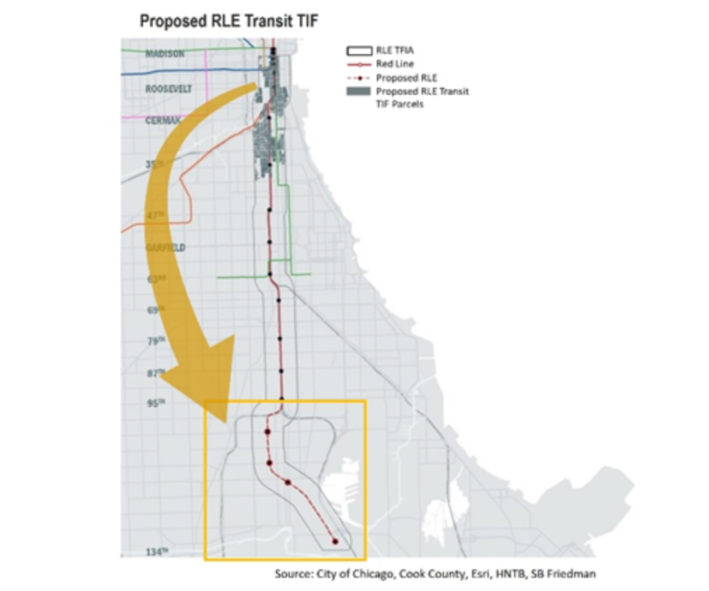A few days ago I wrote about why all Chicagoans, especially transit advocates, should support the proposed transit tax-increment financing district that would raise a projected $959 million to help pay for the $3.6 billion South Red Line extension. The route would run 5.6 miles from the 95th-Dan Ryan station in Roseland to 130th Street in Altgeld Gardens, through predominantly African-American areas, where people have been asking for ‘L’ service since the 1970s. It’s projected to cut 30 minutes off the one-way transit commute time from 130th Street to the Loop.
The funding proposal has been controversial. Unlike the transit TIF that is helping to pay for the Red and Purple Modernization project on the North Side, the new district would capture property tax revenue from relatively prosperous parts of town, including the Loop and the Near South Side, and redistribute that wealth to the struggling Far South Side, making it a "Robin Hood" initiative. And some alderpersons have argued that, since the 'L' system is having major problems with unreliable service due to staffing shortages, plus violent crime, especially on the Red Line, it makes no sense to invest further in the system.

But Far South Siders been asking for this project for over half a century, and it would also have major racial equity benefits for a long-neglected part of town. The extension is estimated to increase the number of jobs that can be reached within an hour from the project area by 46 percent. It will also spur investment in housing and retail along the corridor. And by making it easier for people in lower-income communities of color to access work, education, healthcare, and retail, it will improve life incomes and create more prosperous and peaceful communities. That's in the interest of all Chicagoans.
Today the transit TIF proposal was made official as Mayor Lori Lightfoot introduced the initiative to the City Council. "The Red Line Extension project represents one of the most critical investments in CTA's history and will undoubtedly be a transformative development for our Far South Side community," Lightfoot in a statement. "Not only will this project correct a decades-long lack of rail access for community members, but it will also connect them to jobs, education, and commerce, as well as bolster the economic development of their neighborhoods. This project has been a long time in the making, and I am thankful to all of the government, community and labor partners who have been deeply involved in making it a reality."
The proposed legislation includes three measures:
- The designation of a RLE Transit Facility Improvement Area, where TIF revenues could be spent on the project. The TFIA includes property located within one-half mile of existing and proposed Red Line right-of-way between Madison and 130th street.
- The designation of a RLE Redevelopment Project Area, where new property tax growth would provide TIF assistance for the project. The RPA includes 7,726 parcels on approximately 1,445 acres of land located within one-half mile of Red Line right-of-way between Madison and Pershing Road.
- The adoption of a RLE TIF Redevelopment Plan, which outlines the project scope, budget, and use of TIF funds.
The project would include four new stations at 103rd Street near Eggleston Avenue; 111th Street near Eggleston Avenue; Michigan Avenue near 116th Street; and 130th Street near the Altgeld Gardens housing project. The plans also call for park-and-ride facilities at each station (obviously building lots of parking, as opposed to housing, retail, and other amenities, near stations is not a great strategy) and a new railcar storage and maintenance facility at 120th Street.

“The Red Line Extension will be one of the single biggest investments on the Far South Side in decades,” said recently embattled CTA president Dorval R. Carter, Jr. in a statement. “At CTA, we are dedicated to community involvement when it comes to our projects and always want to hear the voices of Chicago residents. RLE has been a community-input-driven project from the start, and members of the surrounding communities will remain vital in helping shape this project and its path forward.”
Passing the TIF could unlock up to $2.1 billion in Federal Transit Administration funding for the extension. The project has already received a $30 million U.S. Department of Transportation grant, and the CTA is gunning for additional federal, state, county, and Regional Transportation Authority cash.





